
"Layout settings" tab for toner-based digital presses (HEIDELBERG Versafire)
![]() Prerequisite: The icons shown below display only if a digital press that supports duplex printing is used, e.g. HEIDELBERG Versafire presses. If a HEIDELBERG digital press with only single-sided printing (Labelfire) is connected, you cannot select a sheet layout type because "Single-sided" is always set as the layout type.
Prerequisite: The icons shown below display only if a digital press that supports duplex printing is used, e.g. HEIDELBERG Versafire presses. If a HEIDELBERG digital press with only single-sided printing (Labelfire) is connected, you cannot select a sheet layout type because "Single-sided" is always set as the layout type.


You can select one of the following layout types:
| Single-sided layout In this layout type, document pages are only output on the front of the substrate. |
| Double-sided layout In this layout type, document pages are placed so that the first page is placed on the front of the substrate and the second page on the back, the third on the front again, and so on. The back pages are oriented the same as the front pages. |
| Calendar layout In this layout type, the document pages are placed so that the first page is placed on the front of the substrate and the second page on the back, the third on the front again, and so on. The back pages are oriented upside down facing the front pages (like a flip-over calendar). |
| Booklet layout This layout type creates a booklet that can be, for example, folded and bound with perfect binding or saddlestitching. |
| Scheme Editor You invoke the Scheme Editor with this button. See Scheme Editor. |
| Montage Editor |
Using the simplex or duplex setting from the PDF Toolbox for Versafire machines
With the Prinect PDF Toolbox, you can use the "Assemble Documents" tool to predefine layouts and set up simplex or duplex printing. This information is applied to the Versafire presses when processing a job that was created using the "Assemble Documents" tool. In this case, the settings are applied as follows:
•If simplex printing was set up, the layout is always set to "Single-sided".
•If duplex printing was set up, the layout is set to "Double-sided" unless a calendar or booklet layout was selected. Then this selected layout is applied.
If you selected a "Booklet" layout, you can choose between "Perfect Binding" and "Saddlestitch" as the binding method in this list box.
•Saddlestitching:
All sheets are first collated and then folded.
•Perfect binding:
All sheets are first folded and then collated.
•Saddlestitching right:
For some Asian languages (e.g. Japanese, Korean, Chinese), the book margin is on the right. You can set saddlestitching to the "right" for this.
•Perfect binding right:
For some Asian languages (e.g. Japanese, Korean, Chinese), the book margin is on the right. You can set perfect binding to the "right" for this.
![]() Prerequisite: The "creeping" option can only be used when "Booklet Printing" is set as the layout type or if a booklet printing scheme was created with the Scheme Editor and "Create two-page spreads for booklet" was used in this process. See Scheme Editor.
Prerequisite: The "creeping" option can only be used when "Booklet Printing" is set as the layout type or if a booklet printing scheme was created with the Scheme Editor and "Create two-page spreads for booklet" was used in this process. See Scheme Editor.
When brochures - with saddle stitching or eyelet stitching - are put together, the printed sheets are folded in the gutter and nested. If the brochure is to have a cover, the cover pages are placed around the outside of the content pages and the brochure is stitched. Nesting the press sheets results in a displaced back margin in which the content pages in the middle are displaced outwards. The more pages are stitched together and the heavier the grammage of the printed sheets, the greater the value of the displacement.
If the publication is trimmed after stitching or binding, the inside pages will have narrower outer margins than the outside pages. The same is true for perfect binding when large sheets with many pages must be folded often.
Shifting the inner pages outwards is compensated for by shifting them inwards by the entered displacement value V, i.e. the contents of the inner pages are shifted inwards, which leads to a narrowing of the gutter. In extreme cases, this can lead to a disappearance of the gutter for the inner page pairs and even to overlaps between the content pages of a sheet. This problem can be solved by symmetrically reducing the page widths for each printed sheet by the amount of the displacement or the increase in the gutter by scaling. The width of the gutter, i.e. the distance between the left and right sides of a printed sheet, is retained.
The creeping value V that you can set in this box compensates for creeping between two successive two-page spreads, resulting in the page contents lying accurately one on top of the other after trimming. The value determines the offset per fold layer.
Please note that a positive value displaces the inner pages towards the inside, and a negative value displaces the inner pages toward the outside.
As creeping value V, specify twice the thickness value of the used printing material. See Create / modify printing materials.
![]() Note: In "Administration > Templates", you can choose between two creeping methods in a PagePrint sequence for digital presses that support this function:
Note: In "Administration > Templates", you can choose between two creeping methods in a PagePrint sequence for digital presses that support this function:
•Creeping by scaling.
The creeping value causes the width of the page contents being scaled. The value for creeping by scaling is specified in the unit of measurement defined in the Preferences of Cockpit (Administration > Preferences). See Units.
•Creeping by offset:
The creeping value causes a linear displacement and, consequently, a change of the gutter width or of the page offset on the sheet layout. The unit of measurement is the one specified in the preferences of Cockpit (Administration > Preferences. See Units.
![]() Note: You can toggle between the creeping methods in a PagePrint sequence only in "Administration > Templates" and not in an open print job. See also Layout settings > Booklet settings > Creeping.
Note: You can toggle between the creeping methods in a PagePrint sequence only in "Administration > Templates" and not in an open print job. See also Layout settings > Booklet settings > Creeping.
Creeping Marks/Fixed Marks
This option can be used to adjust the position of the cut marks to the desired end product, depending on whether the folding sheets are to be nested (saddlestitching) or stacked one on top of the one another (perfect binding). Creeping compensates the shift of the inner pages outwards. The setting is taken into account in all cases except when the schema only contains one page. The cut marks are not shifted inwards if the "Fixed Marks" setting is set.
By clicking the icon for fixed marks/creeping marks, you can toggle between the following conditions:
| The page cut marks are moved with the creeping. |
| Fixed Marks: Even if a creeping value is defined, the cut marks remain at the same position. |
![]() Prerequisite: The "Back Margin" box can only be used when "Booklet Printing" is set as the layout type.
Prerequisite: The "Back Margin" box can only be used when "Booklet Printing" is set as the layout type.
In this box you can define the width of the back margin in booklet printing. Accordingly, the pages on a sheet are moved apart from each other.
"Gripper for Saddlestitcher (Collator)" option
Normally, a strip of the substrate is needed to pull the folding sheets onto the saddle if a saddlestitcher is used to collate the sheets. The position of the gripper margin on the folding sheet depends on the folding sheet scheme. The folding sheet becomes bigger because of the gripper margin. As a result, all the pages are shifted.
Choose between a front fold and rear fold if you need a gripper margin.
•Not Present
•Fold Rear
Gripper margin on the back of the folding sheet
•Fold Front
Gripper margin on the front of the folding sheet
![]() Note: In the preview of the "Digital Printing" window, the sheets are shown so that their orientation corresponds to the way paper runs through the press. In other words, the sheets run through the press from right to left in the orientation shown. The back of a sheet is always thus the right side in the display and the front is always the left side.
Note: In the preview of the "Digital Printing" window, the sheets are shown so that their orientation corresponds to the way paper runs through the press. In other words, the sheets run through the press from right to left in the orientation shown. The back of a sheet is always thus the right side in the display and the front is always the left side.
"Margin" box
This is where you can enter the width of the gripper margin.
"Press Sheet Layout" group
"AutoArrange Folding Sheets" option
If you enable this option, the pages or, in the case of a booklet, the folding sheets are automatically arranged so that the substrate is utilized as far as possible. In other words, this option uses the maximum values for "columns" and "rows" that are possible with the substrate used.
If the "Repeat" options are checked (for both columns and rows), the pages/folding sheet are arranged by repeating, i.e. they are multiplied. If not, the pages/folding sheets are not duplicated, but placed consecutively.
You can use "Cut and Stack" if you placed a number of different folding sheets on one press sheet.
•Function is not enabled:
Each press sheet is cut separately. The cuts sort out the folding sheets.
The order/arrangement of the pages/folding sheets on the press sheet remains unchanged.
•Function is enabled:
Each printed copy is delivered to several stacks, with the order of pages divided up in such a way that the stacks only have to be laid on top of each other after output to have a complete copy with the correct order of pages.
Example: One copy comprises 500 pages and is delivered to five stacks of 100 pages each. The first stack then has pages 1 thru 100, the second stack pages 101 thru 200, the third stack pages 201 thru 300, etc.
If PDF/VT files (i.e. PDF files with large page ranges defined as "records") are processed, then "Cut & Stack" acts as follows if several data records are placed on one sheet:
•Function is not enabled:
The pages (subjects) of a data record are distributed in succession on the subsequent surfaces. If several pages are to be on one surface, all the unused page positions of the surfaces are filled up after all pages of the first data record are distributed.
Example: Two pages can be placed on one surface. A data record contains four pages. The first data record is then distributed in such a way that one page of the data record is placed on one surface. In other words, four surfaces are filled with data. The pages of the second data record are placed in each case on the second page placeholders of these four surfaces. Four new surfaces, each with one page, are filled with the third data record. The second page placeholders of these surfaces are again filled with the fourth data record, and so on. If the front and back are printed, this is taken into account when assigning the surfaces, resulting in the matching back being printed for a front

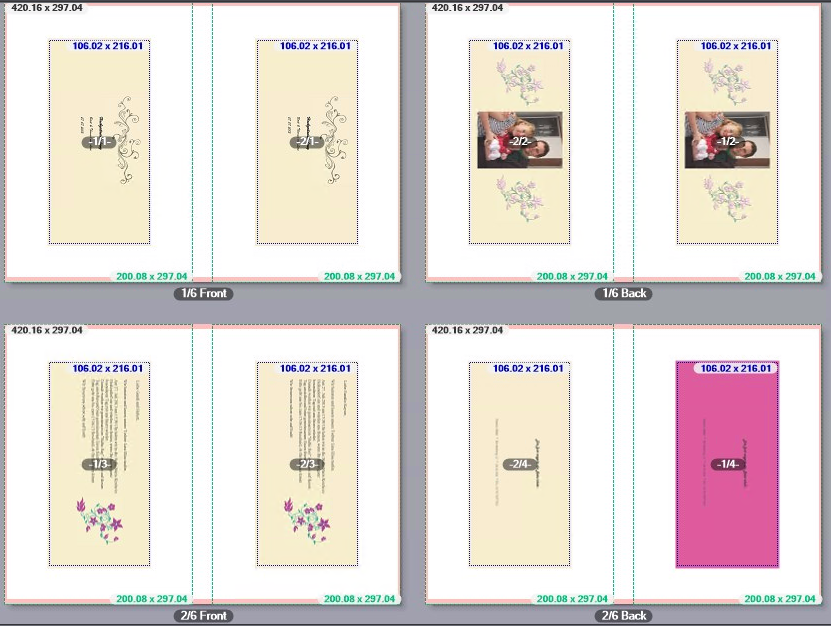
The numbering of the subject identifies the number of the data record/page of the data record, e.g. 2/3 is the third page of the second data record.
•Function is enabled:
In this case, the pages of the data records are split so that the page order is optimized for finishing afterwards. This means that each printed copy is delivered for finishing (cut, stack) to be done so that the stacks only have to be placed one on top of the other after finishing to have complete copies in the correct page order.

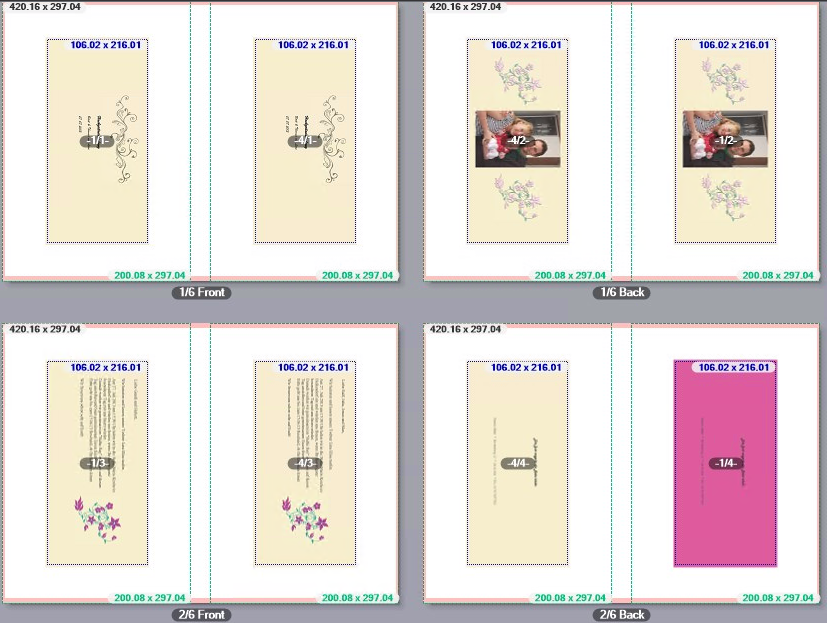
In the example shown, the first pages of the first and fourth data record are placed on the first surface. The second pages of the first and fourth data record are placed on the second surface (back). The third pages of the first and fourth data record are placed on the fourth surface. The fourth pages of the first and fourth data record are placed on the third surface. The subsequent pages are distributed accordingly on further surfaces.
This is where you define the number of pages/folding sheets on the press sheet.
![]() Prerequisite: These options can be used only if the "AutoArrange Folding Sheets" option is not enabled.
Prerequisite: These options can be used only if the "AutoArrange Folding Sheets" option is not enabled.
You always start off with one folding sheet per press sheet. In other words, folding sheet 1 is placed on press sheet 1, folding sheet 2 on press sheet 2, etc.
The "Repeat" option only has an effect if the "Rows" or "Columns" box contains a number equal to or greater than "2".
•"Rows" without "Repeat"
The "Repeat" option is not enabled. The number in the "Rows" box indicates how many of the pages/folding sheets related to a press sheet will be placed side by side on this press sheet.
Example: In a "Double-sided" layout, page 1 is placed on the front of press sheet 1 and page 2 is placed on the back of press sheet 1.
The "Rows" and "Columns" boxes each contain the number 1 and the "Repeat" options are not enabled:

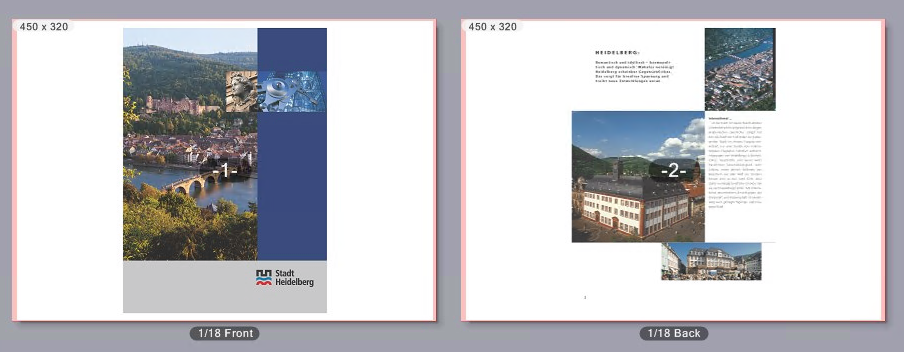
Now enter a "2" in the "Rows" box.
Then pages 1 and 3 are placed side by side on the front side of press sheet 1. In line with this, pages 2 and 4 are placed side by side on the back of press sheet 1.

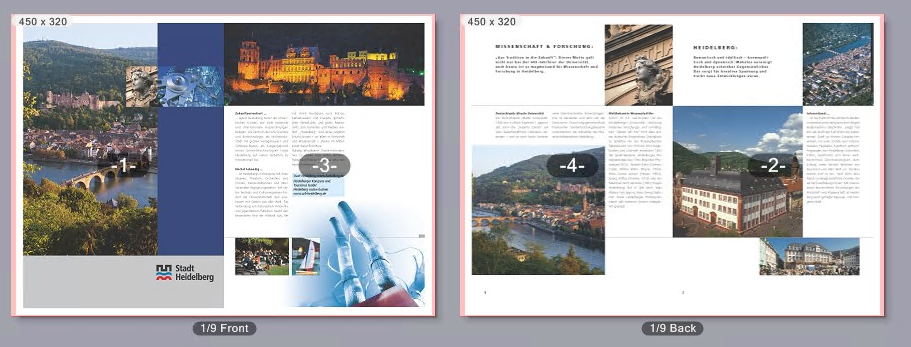
•"Rows" with "Repeat"
In the "Row" box a number equal to or greater than "2" can be entered and the "Repeat" option is enabled.
Then the number in the "Rows" box defines how many repetitions of the pages/folding sheets will be arranged side by side on a press sheet.
Example: In a "Double-sided" layout, page 1 is placed on the front of press sheet 1 and page 2 is placed on the back of press sheet 1.
The "Rows" and "Columns" boxes each contain the number 1 and the "Repeat" options are not enabled:


Enter a "2" in the "Columns" box and enable "Repeat" beside the "Rows" box.
Then, page 1 is placed twice side by side on the front side of press sheet 1. In line with his, page 2 is placed twice side by side on the back of press sheet 1.

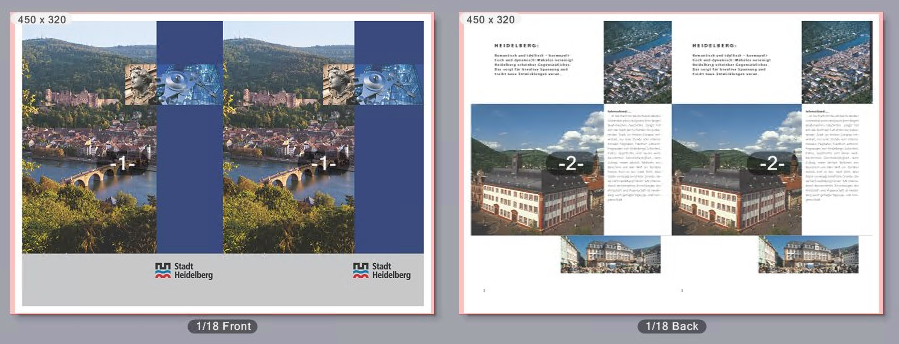
•"Columns" with/without "Repeat"
The behavior is the same as described above for "Rows" with/without "Repeat", only that the pages/folding sheets are arranged one below the other.
•"Rows and "Columns" with/without "Repeat"
If the sheet is large enough for at least four pages to be placed on a surface, you can set a number equal to or greater than "2" for rows and for columns. Then four pages are placed on each surface. The behavior with or without "Repeat" is equivalent to that for two placed pages in each case.
![]() Note: Whenever a number greater than "1" is entered in the "Columns" or "Rows" boxes, a graphic displays in the lower part of the "Layout settings" tab where you can individually set the orientation of the single folding sheets and the spacing between the folding sheets. See Custom folding sheet settings for spacing and rotation angles.
Note: Whenever a number greater than "1" is entered in the "Columns" or "Rows" boxes, a graphic displays in the lower part of the "Layout settings" tab where you can individually set the orientation of the single folding sheets and the spacing between the folding sheets. See Custom folding sheet settings for spacing and rotation angles.
"Rotation" option (angle sign)
In this list box, you can set a rotation angle for all pages/folding sheets placed on the surfaces. In doing so, the page content is rotated too.
In the "Double-sided" and "Booklet Printing" layouts, the pages are always rotated so that the front and back pages of the document pages are rotated synchronously. In the settings for a "Calendar" layout, the pages are always rotated so that the front and back pages of the document pages are rotated in opposite directions.
If only one page/folding sheet is placed on a surface, the rotation angles 0°, 90°, 180° or 270° clockwise are available.
Example: Two pages are placed on a sheet with the "Double-sided" setting. Parameters: Columns = 2, Repeat = Off.
The angle of rotation is set to "0°":
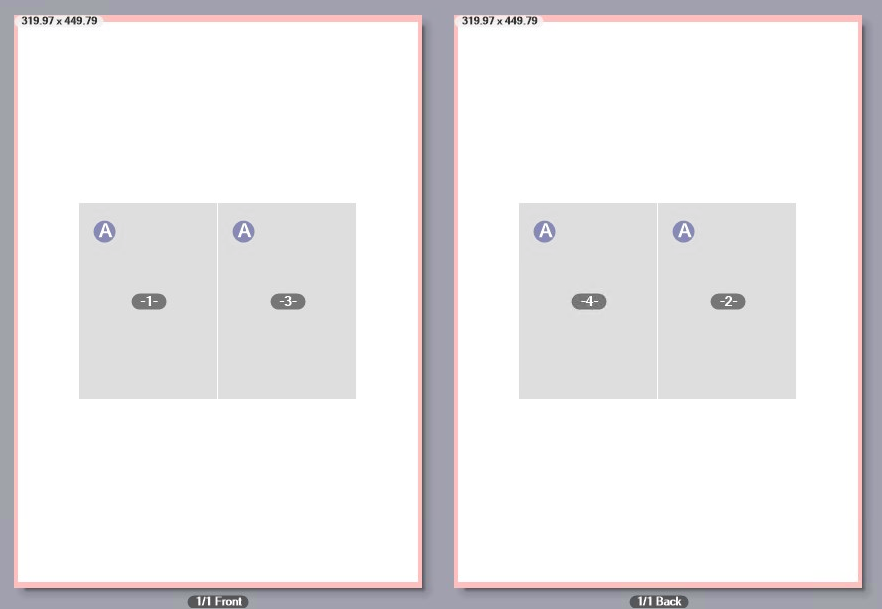
The angle of rotation is set to "90°":
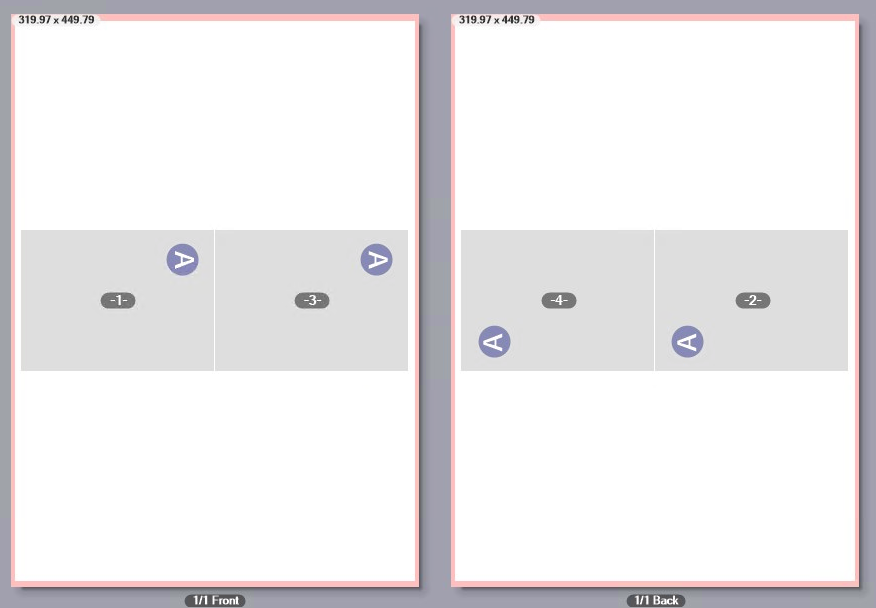
The angle of rotation is set to "180°":
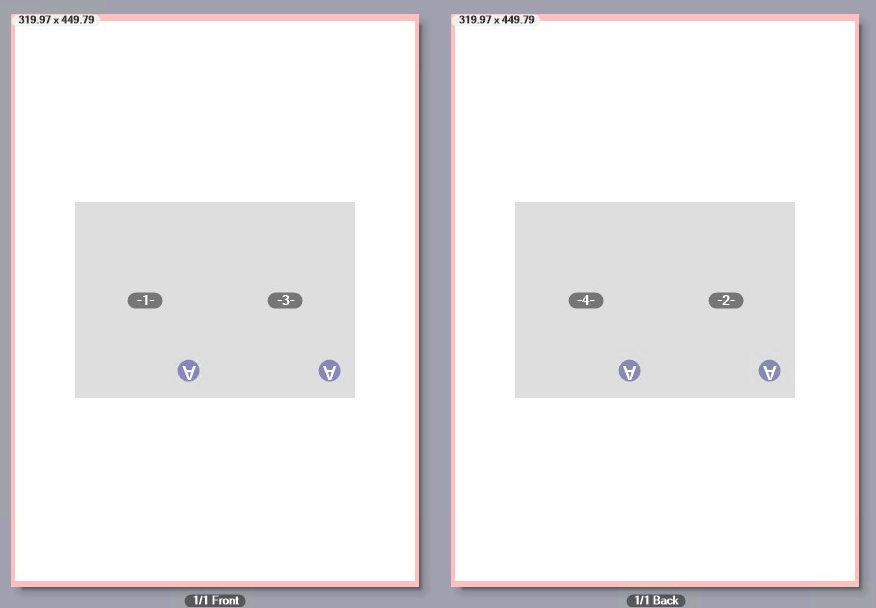
The angle of rotation is set to "270°":
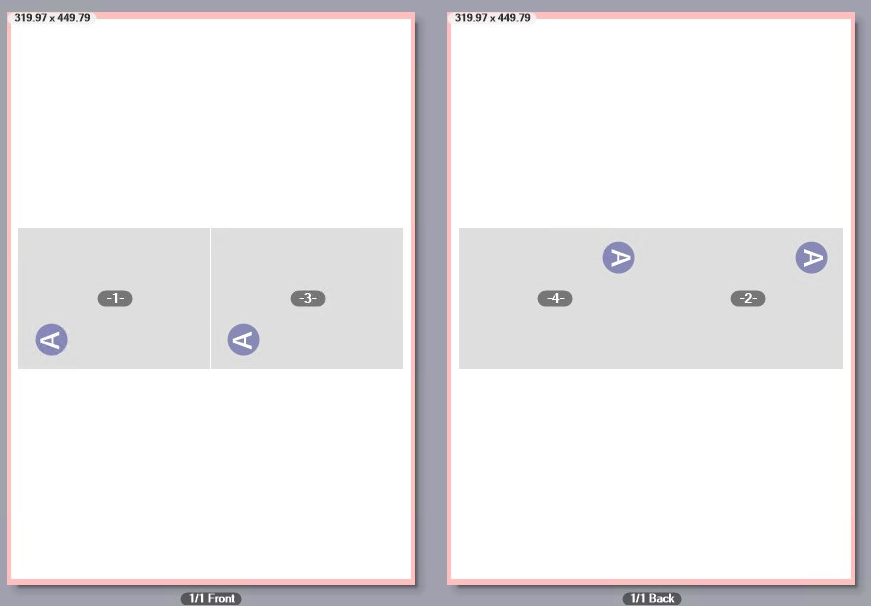
Custom folding sheet settings for spacing and rotation angles
If a number greater than "1" is entered in the "Columns" and/or "Rows" boxes, a graphic displays in the lower part of the "Layout settings" tab where you can individually set the orientation of the single folding sheets and the spacing between the folding sheets.
![]() Prerequisite: The "AutoArrange Folding Sheets" option must not be enabled to be able to use this function. In addition, this function is available only for the "Single-sided", "Double-sided", "Calendar" and "Booklet" layout types.
Prerequisite: The "AutoArrange Folding Sheets" option must not be enabled to be able to use this function. In addition, this function is available only for the "Single-sided", "Double-sided", "Calendar" and "Booklet" layout types.
When you click a folding sheet in the graphic, you can edit the orientation of this folding sheet. You can rotate a row or column by clicking the rotate icon in front of the row or column. This orientation displays in the preview pane.
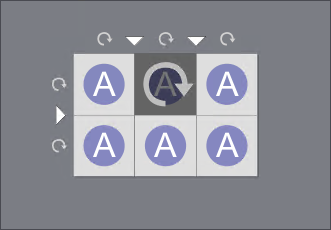
With these settings, the pages/folding sheets on a surface (front or back) are counter-rotated. In addition, the pages are oriented on the surface in the set angle. Orientation of the back depends on the selected layout type. See Selection of the layout type.
Example: Two pages are placed on a surface with the "Double-sided" setting. Parameters: Columns = 2, Rows = 1, Repeat = Off.
Rotation angle = setting "0°", the right side in the graphic is rotated:
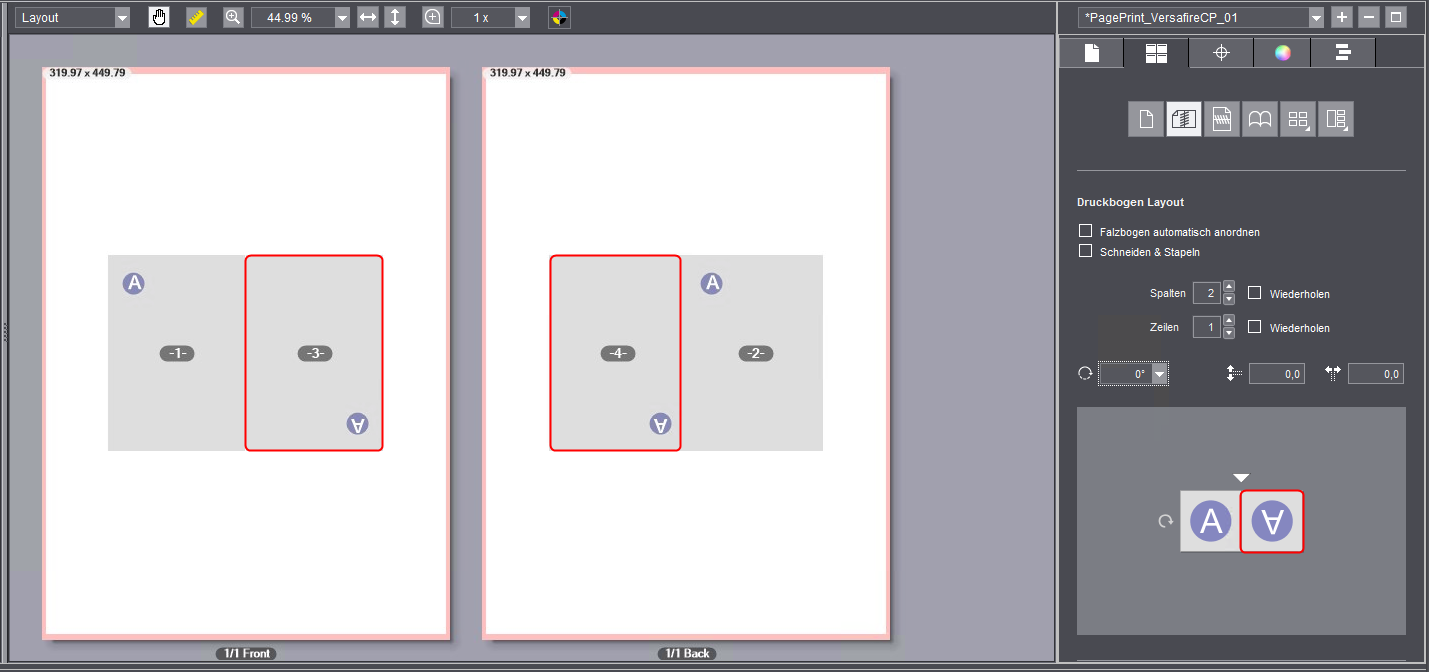
The pages are rotated to each other so that the pages are counter-rotated on every sheet, with the first page on the front surfaces unrotated and the second page rotated by 180°. The corresponding pages on the back surfaces are oriented the same as the front.
Rotation angle setting "90°", the right side in the graphic is rotated:
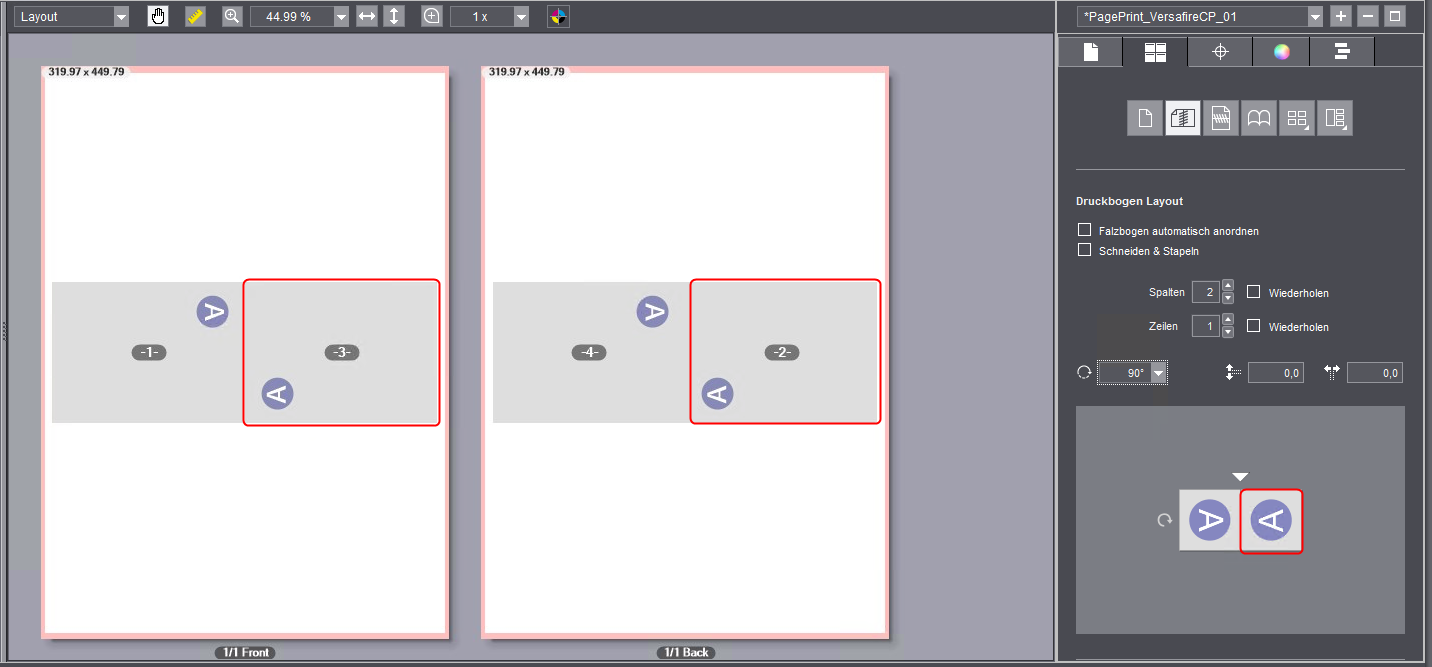
The top edges of the pages face each other.
Rotation angle setting "270°", the right side in the graphic is rotated:

The bottom edges of the pages face each other.
Rotation angle setting "180°", the right side in the graphic is rotated:
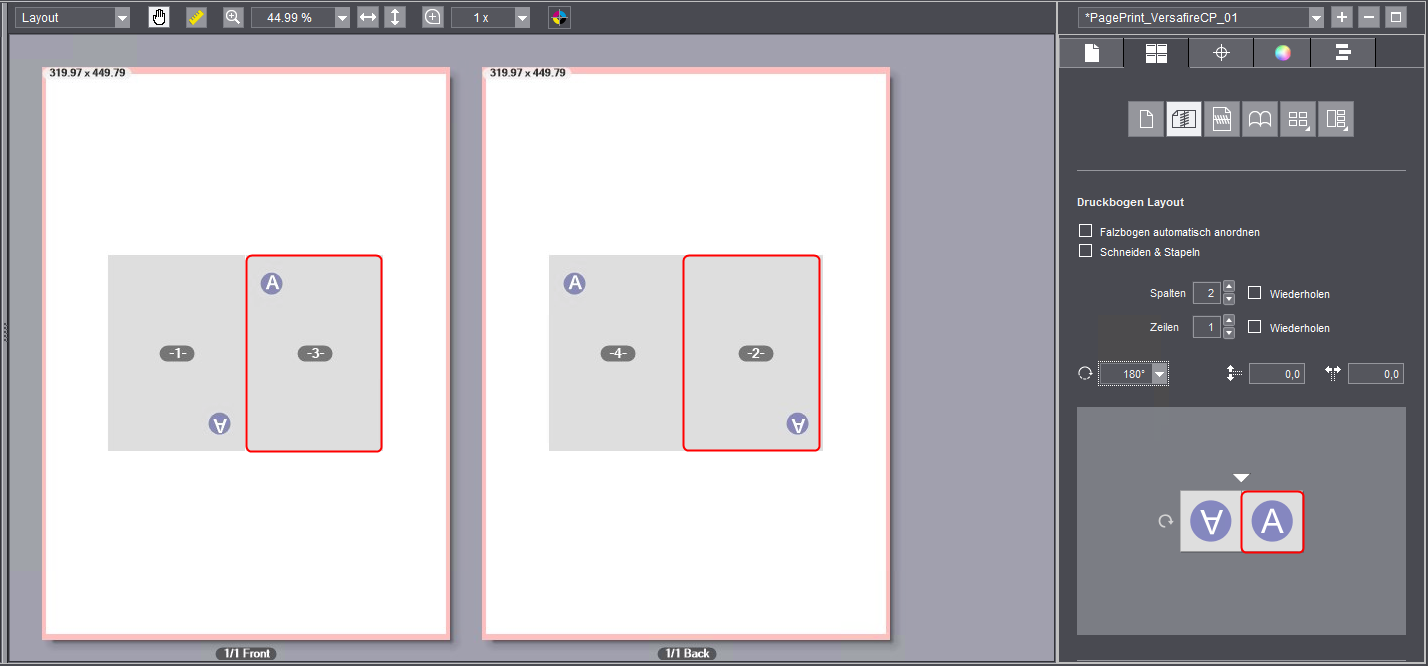
The pages are rotated to each other so that the pages are counter-rotated on every sheet, with the first page on the front surfaces rotated by 180° and the second page unrotated. The corresponding pages on the back surfaces are oriented the same as the front.
"Vertical/horizontal distance" options
![]() Prerequisite: More than one page/folding sheet are placed in horizontal and/or vertical direction on the sheet layout.
Prerequisite: More than one page/folding sheet are placed in horizontal and/or vertical direction on the sheet layout.
With these options you can set up the vertical and/or horizontal spacing between the pages or folding sheets.
| Vertical spacing between folding sheets. |
| Horizontal spacing between folding sheets. |
Set folding sheet spacing individually
If you wish to set the spacing between single folding sheets individually that is different to the vertical and horizontal spacing, you can do this in the preview graphic.
![]() Prerequisite: The "AutoArrange Folding Sheets" option must not be enabled to be able to use this function.
Prerequisite: The "AutoArrange Folding Sheets" option must not be enabled to be able to use this function.
In the graphic, click the arrow for the separating line concerned and enter the spacing you want in the input box (in mm).
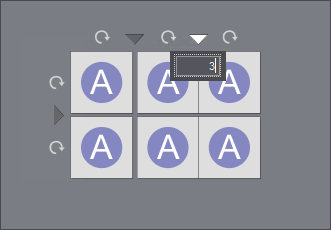
The spacing displays in the graphic and also in the preview window for the separating line. If needed, you can set other spacings.
"Sort Order" option
![]() Prerequisite: This option is available only for some Versafire digital presses.
Prerequisite: This option is available only for some Versafire digital presses.
If you want to edit layouts with multiple folding sheets per press sheet, the folding sheets are usually always arranged first from left to right and then from top to bottom. For certain finishing steps, you must be able to define individual sorting orders for folding sheets, for example, from right to left and from top to bottom.
Two list boxes are available:
•In the first list box, you can use an arrow to select the first direction in which they will be arranged.
•Accordingly, in the second list box, select the second direction in which they will be arranged.
Privacy Policy | Imprint | Prinect Know How | Prinect Release Notes









